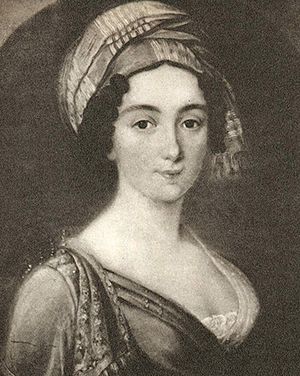Mathilda d'Orozco facts for kids
Mathilda Valeria Beatrix d'Orozco was a very talented woman from Sweden. She was born on June 14, 1796, and passed away on October 19, 1863. Mathilda was known for many things. She was a noblewoman and hosted popular social gatherings called salons. She also wrote music and poems, sang beautifully, acted, and played the harpsichord.
Contents
Mathilda's Life Story
Mathilda was born in Italy. Her father, Count Nicolas Blasco d'Orozco, was the Spanish ambassador (a country's representative) in Milan. Her mother was Sabina Lederer.
Her Marriages and Family
Mathilda first married a man named Marquess Cenami. He was in charge of the horses for Princess Elisa Bonaparte, who was Napoleon's sister. Mathilda became a widow (her husband died) before she was twenty years old.
In 1817, she married again in Vienna. Her second husband was a Swedish Count named Josias Montgomery-Cederhjelm. He was a colonel (a high-ranking army officer). They had four children together. Sadly, he passed away in 1825.
In 1839, Mathilda married for a third time. Her husband was a Swedish Baron (another type of noble title) named Carl Alexander Fredrik Gyllenhaal.
Life in Sweden
After her second marriage in 1817, Mathilda d'Orozco moved to Sweden. She lived there for the rest of her life. In Sweden, she became very well-known in high society. People called her "one of the most noted ornaments in the salons." This means she was a bright and popular person at social gatherings. These gatherings happened during the time King Charles XIV John ruled (1818–1844).
Mathilda was used to the warm weather in Italy. She once joked, "God was angry when he created the Swedish climate!" People described her as a warm and charming person. She had many artistic talents, which she shared at her lively social events.
A Star at Court
Because she was a noblewoman, Mathilda was introduced at the royal court. This was the official home and circle of the King and Queen. She took part in the court life of King Charles John and Queen Désirée. She became a central part of their entertainment.
Mathilda was a wonderful singer. She often played the harp while she sang. She also acted in plays put on by the royal court. People said she was an amazing actress and a graceful dancer. Even the Crown Prince, Oscar, and the British ambassador admired her.
After her third marriage in 1839, Mathilda spent less time in society. She moved to her husband's home in the countryside. She only visited the seaside town of Norrtälje once a year. She passed away at the age of 67 in Stora Ekeby, Sweden.
A poet named Gustaf Lagerbjelke even wrote a poem for her called "L'une et l'autre."
Mathilda's Amazing Creations
Mathilda d'Orozco was a very creative person. She wrote many songs, piano pieces, and poems.
Songs and Piano Music
She wrote many pieces for piano and singing. Here are some of them:
- Axels monolog (words by Esaias Tegnér)
- Frithiofs lycka (words by Esaias Tegnér)
- Fogelleken (words by Esaias Tegnér) (Stockholm, 1829)
- Four songs with piano music (dedicated to Charlotte Åkerhielm, 1829)
- 1. Stjernsången (Tegner)
- 2. Wågen (Karl August Nicander)
- 3. Drömmen till Laura (Beskow)
- 4. Jag vill ej drömma mer (Beskow)
- Songs with piano music (dedicated to Carlotte von Kraemer, 1833)
- Jag gick med lyran i min hand (Carl Wilhelm Böttiger)
- "Dit bort"
- Vår
- Afskeds önskan
- Kärlek eller vänskap (Thomas Moore)
- Songs with piano music (dedicated to Fredrika Bremer, 1834)
- Säg hvar finns ett enda troget hjerta
- Echo i Ådalen
- Gå ej bort.
- Four piano pieces (1839)
- Galer slafven (C. C. G.)
- Romanza
- Hambo polska
- Hoppet
- Songs with piano music (dedicated to her daughter Eugenie)
- Negerflickans klagan
- Nordens kämpe
- Den blinda sångarn
- Duo, or Hoppet än med klara strålar
- Fyren.
- Six songs with piano music (dedicated to Marie von Stedingk, 1842)
- Frågan (X.)
- Indiansk waggvisa (H. H.)
- Du är borta (M. M.)
- Den öfvergifna (R. Hjärne)
- Galloppen
- Han kommer ej (L. Bn o.)
- Sveriges främsta Ädling. (words by Carl Wilhelm Böttiger, dedicated to Magnus Brahe (1790–1844), 1845)
- Barcarolle (1861)
- Songs with fortepiano (dedicated to Prince Gustaf, Duke of Uppland)
- Lilla Fogeln
- Illusionen
- Den vissnade Blomman
- Min Philosophi
- Wikings-sången (Herman Sätherberg)
- Dryckes-Wisa
- Afsked från Hemmet (Herman Sätherberg)
- Four songs with piano (dedicated to Oscar II)
- Främlingens syn (Johan Ludvig Runeberg)
- "Italia" (Carl Wilhelm Böttiger)
- Höstqvällen
- Wikinga-sången (G.H.S.)
- Four songs with piano (1839)
- Romance (Je vous l'ai dit, je vous adore)
- Strödda tankar (Karl August Nicander)
- I recitativ manér (Era l'ora che volge il desiro) (words from Inferno (Dante))
- Strömmen (Johan Gabriel Carlén)
- Seven songs with piano (1856)
- Jag följer dig
- Champagne-ruset (Wilhelm von Braun)
- Om hundra år (S_dt)
- "Qvinnoögat" (Wilhelm von Braun)
- "Till min Dotter!"
- "Lycklig du!" (L_a)
- Någonstädes gumman Lenngren säger (E. S_dt)
- Vid Julbrasan för några år sedan (P. K. L., 1854)
- Povera Italia mia!.
- Den bedragna.
- La Serenata Contadinesca con risporta dalla Finestra
- Rings Drapa.
Just Piano Music
She also wrote music just for the piano:
- Hussar-Marsch, Norstedt & söner, Stockholm, 1854.
- Svenska arméns Revelje och Tapto (1865)
Her Poems
Mathilda also wrote a collection of poems:
- Dikter (1870)


